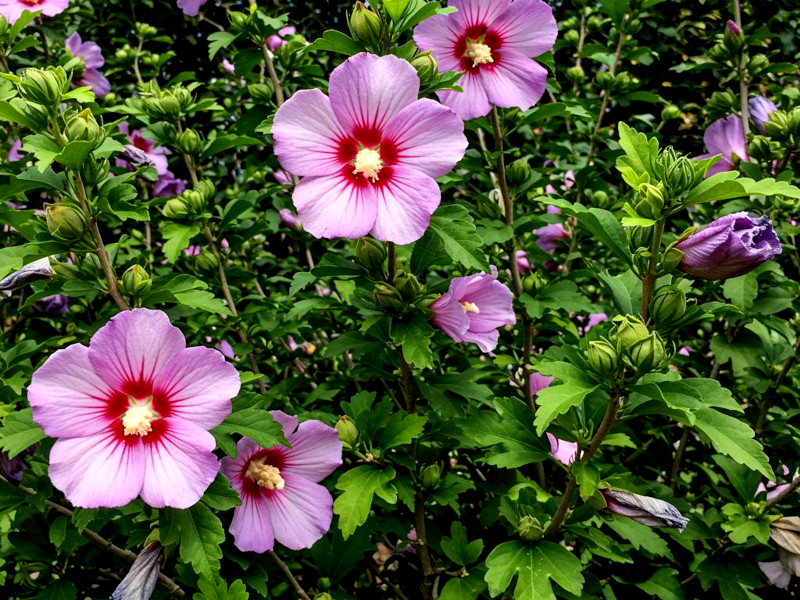Wise Mind Herbs
Evidence-based Herbal Healing
The information on this page has been prepared with reference to published scientific literature, not by a medically qualified expert. It is not medical advice. Any decision to use a supplement or herb-based product is your responsibility. Consult a suitably qualified medical professional, especially if you have underlying conditions. Remember, nothing is for everyone, and not everything sold is what it claims to be. Some things work for some people, some of the time.
Hibiscus syriacus
Hibiscus syriacus, commonly known as Rose of Sharon, Rose Mallow, Korean Rose, or Syrian Ketmia, is a flowering shrub in the Malvaceae family. It is important to distinguish this species from Hibiscus sabdariffa (Roselle), which is more extensively studied for medicinal properties and commonly used in herbal teas. The scientific literature on Hibiscus syriacus specifically is more limited compared to other Hibiscus species.

Botanical Classification and Common Names
Botanical name: Hibiscus syriacus L.
Common names: Rose of Sharon, Shrub Althea, Syrian Hibiscus, Korean Rose, Rose Mallow, Syrian Ketmia
Often confused with: Hibiscus sabdariffa (Roselle), Hibiscus rosa-sinensis (Chinese Hibiscus), Althaea officinalis (Marshmallow)
Reported Health Benefits
Research on Hibiscus syriacus has identified several potential health benefits, though most studies are preliminary and conducted in vitro or in animal models rather than human clinical trials:
- Antioxidant properties: Extracts demonstrate free radical scavenging activity
- Anti-inflammatory effects: Studies suggest potential for reducing inflammatory responses
- Antimicrobial activity: Some evidence for inhibitory effects against certain bacteria
- Neuroprotective effects: Limited evidence for potential benefits in cognitive health
- Antidiabetic properties: Some studies indicate possible glucose-regulating effects
- Hepatoprotective effects: Limited evidence for liver-protective properties
Active Compounds
Hibiscus syriacus contains several bioactive compounds that may contribute to its potential health benefits:
- Flavonoids (quercetin, kaempferol derivatives)
- Anthocyanins
- Coumarins
- Triterpenes
- Polysaccharides
Dosage Recommendations
No standardized dosage recommendations exist for Hibiscus syriacus as it is not commonly used in clinical practice. Unlike Hibiscus sabdariffa, which has established dosing guidelines for tea preparations (typically 1.5-2g of dried calyces per cup), H. syriacus lacks clinical dosing studies. The absence of standardized preparations makes it difficult to provide reliable dosage information. Most research uses varied extract concentrations that cannot be easily translated to consumer use.
Studies on Dose-Response Relationship
There is a significant knowledge gap regarding dose-response relationships for Hibiscus syriacus. No comprehensive studies have investigated doses above potentially efficacious ranges, and maximum tolerable doses have not been established in humans. This represents a substantial limitation in the current research and highlights the need for more systematic clinical investigations before therapeutic recommendations can be made.
Side Effects and Contraindications
While generally regarded as safe in traditional use, scientific data on safety profiles is limited:
- Potential allergic reactions in sensitive individuals
- Possible interaction with antihypertensive medications (theoretical, based on effects seen with other Hibiscus species)
- No documented toxicity studies specific to H. syriacus in humans
- Contraindicated during pregnancy and lactation due to insufficient safety data
Commercial Pharmaceutical Products
Currently, there are no approved pharmaceutical products (prescription or over-the-counter medications) specifically utilizing Hibiscus syriacus extracts or their synthesized homologues. Most commercial applications are limited to cosmetic products, nutraceuticals, or traditional herbal preparations rather than regulated pharmaceutical agents. This distinguishes it from some other medicinal plants that have been developed into standardized pharmaceutical products.
Research Limitations and Knowledge Gaps
The scientific literature on Hibiscus syriacus presents several important limitations:
- Lack of well-designed human clinical trials
- Insufficient standardization of extracts used in research
- Limited understanding of bioavailability and pharmacokinetics
- Minimal data on long-term safety and potential drug interactions
- No comprehensive meta-analyses specifically focusing on H. syriacus
Conclusion
While preliminary research suggests potential health benefits for Hibiscus syriacus, the current evidence is not robust enough to support definitive medical recommendations. Most studies are preclinical, and there is a notable absence of high-quality human trials. No conditions can be considered "cured" by H. syriacus based on current scientific evidence. More rigorous research, particularly randomized controlled trials with standardized preparations, is needed to establish efficacy, optimal dosing, and safety profiles before this plant can be recommended for specific therapeutic applications.
References
Alharbi, A. E., AlHussaini, A. M., & Alshami, I. (2024). A Comprehensive Review of the Antimicrobial Effects of Hibiscus Species. Cureus, 16(11).
Chen, J., Ye, C., Zhang, L., Xie, Z., Zhu, J., & Zhang, Z. (2025). Preparation, structural property, and antioxidant activities of a novel pectin polysaccharide from the flowers of Hibiscus syriacus Linn. Frontiers in Nutrition, 11, 1524846.
Choi, Y., Park, Y. H., Yang, C., Kim, D. H., Lee, K. W., & Lee, M. Y. (2023). Protocol for a randomized controlled trial evaluating the effect of Hibiscus syriacus L. flower extract on sleep quality. Frontiers in Nutrition, 10, 1169193.
Geum, N. G., Yu, J. H., Park, S. J., Choi, M. Y., Lee, J. W., Park, G. H., ... & Jeong, J. B. (2022). Immunostimulatory activity of Hibiscus syriacus L. leaves in mouse macrophages, RAW264. 7 cells, and immunosuppressed mice. Korean Journal of Plant Resources, 35(6), 697-703.
Im, S. W., Park, G. H., Choi, M. Y., Kwon, H. Y., & Jeong, J. B. (2023). Hibiscus syriacus Leaves Upregulate p62/SQSTM1 through TLR4/p38, JNK, and NF-κB/Nrf2 Signaling Pathway in RAW264. 7 Cells. Korean Journal of Plant Resources, 36(3), 191-197.
Kapoor, M., Kaur, G., Kaur, N., Sharma, C., Batra, K., & Singh, D. (2021). The traditional uses, phytochemistry and pharmacology of Genus Hibiscus: a review. Eur. J. Med. Plants, 32(4), 1-37.
Zhang, P., Li, Y., Chong, S., Yan, S., Yu, R., Chen, R., ... & Zhang, X. (2022). Identification and quantitative analysis of anthocyanins composition and their stability from different strains of Hibiscus syriacus L. flowers. Industrial Crops and Products, 177, 114457.
Ziyanok-Demirtas, S. (2024). A holistic in silico and in vivo approach to exploring the antidiabetic, antioxidant, and hepatoprotective properties of rose of sharon. Life, 14(6), 686.